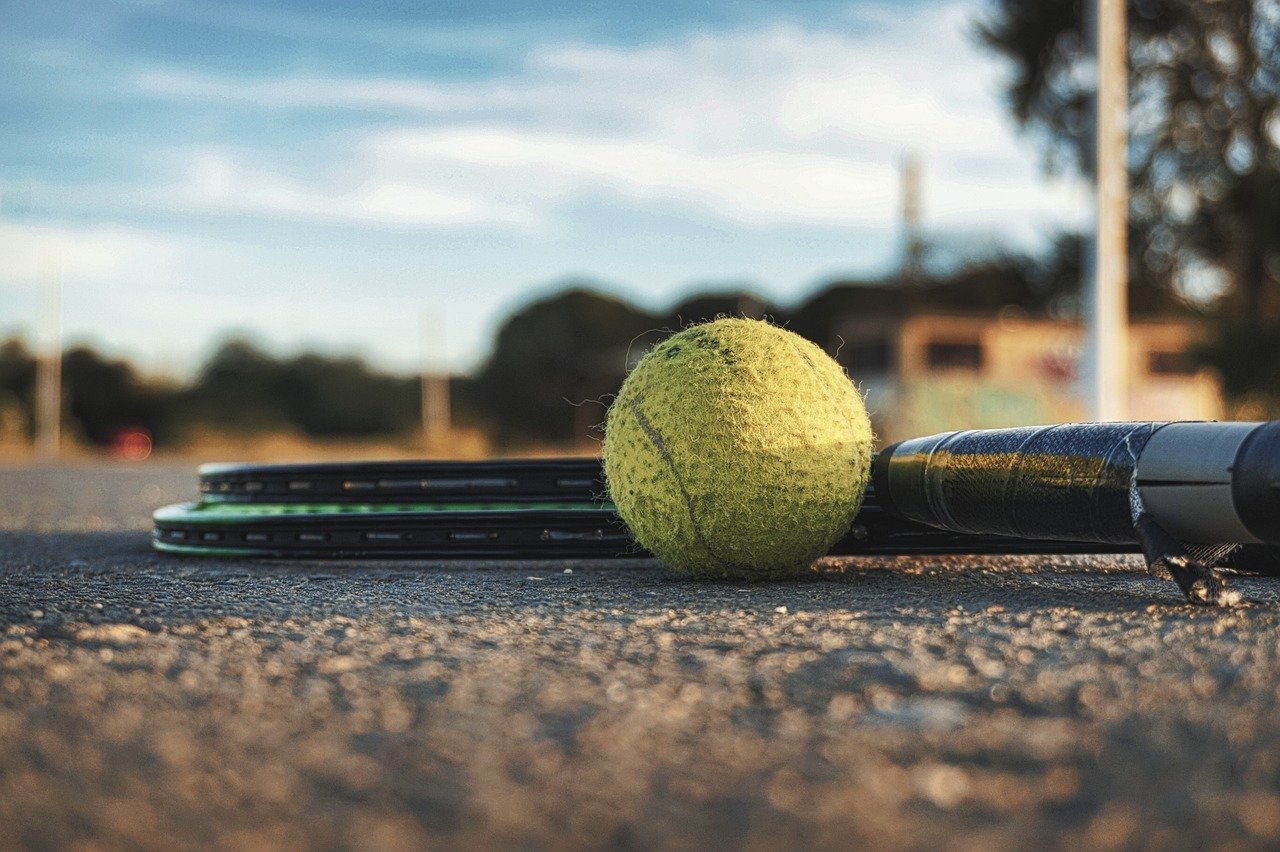Like most people, I enjoyed watching the Olympics. Some of us might even imagine our children becoming elite athletes one day. Unfortunately, becoming a great athlete is prohibitively expensive for most people, requiring significant time and money to achieve greatness.
I’ve played sports all my life and love the activity. Sports bring people from different backgrounds together to work toward a common goal: winning. Sports teach us discipline, demand perseverance, and require resilience. Some of us even learn how to lose or win graciously.
Without sports, my life would be duller, with fewer friends and acquaintances. I’d probably be 20 pounds heavier and sleep less peacefully at night. If you can play sports regularly, I highly recommend it.
You don’t have to be a great athlete. Instead, you just need to be competent. I hope my children pick up at least one sport or physical activity they can enjoy for the rest of their lives. Learning how to perform under pressure is a critical skill for success.
However, like getting into an elite university, I don’t have high hopes that they will become elite athletes. Thankfully, being a great athlete isn’t required to live a great life!
It’s Expensive To Excel In Sports
Becoming a great athlete requires more than just physical fitness; it also demands mental toughness, a strong work ethic, strategic thinking, and being coachable, among other qualities. However, I’d like to focus on the financial cost of becoming a great athlete.
I’m currently in the process of introducing different sports and activities to my children to see what resonates with them. My goal is to help them find something they enjoy, so they can maintain a healthy mental-to-physical balance for a better lifestyle.
Personally, I believe the ideal ratio of mental-to-physical activity is 4:1. In other words, for every four hours spent working or using your brain, you should spend one hour engaged in physical activity. This ratio is especially important if you spend most of your time in front of a computer.
An Interest In Body Movement And Control
One of the activities we’ve enrolled our kids in is acrofitness, a combination of gymnastics and parkour. They love learning how to do tumbles, cartwheels, and run obstacle courses. Mastering body movement and control seems like a good lifetime benefit.
The cost of group lessons, with 5-7 kids, is about $25 per lesson, held once a week. So for a three-month summer session, we’re looking at $300 per child. Not bad, but we noticed after a couple of months that our daughter was progressing faster than the other kids. She started getting bored because some of her classmates would join later with no experience.
Then, during one group class, she got lucky—none of her classmates showed up. It was a 10 a.m. session on a Tuesday, and that’s when I saw how much more she could achieve with 1:1 instruction. She no longer had to wait for the least skilled student before moving on.
The Cost of Private Lessons Is Almost Four Times Higher
Her lucky break coincided with a stock market crash. My stock portfolio lost six figures within a week, much to my dismay.
The more stocks dropped, the more I felt motivated to spend money. I figured it was best to spend more than let the stock market take more of it away. So, I decided to inquire about private lessons for our daughter once her group session ended. The gym said we’d need to coordinate with individual instructors to find a suitable time.
Eventually, we found a Saturday morning time slot for 1:1 lessons at $90 per lesson. Paying an extra $65/lesson feels like a lot. Over a three-month period, the total cost will rise to $1,080 versus $300 for group lessons. And if we decide to continue with private lessons every week for ten months, we’re looking at $3,600.
But here’s the thing: our son loves acrofitness and parkour as well! The two of them enjoy learning and playing together most of the time. As a result, we’ll be paying $160/hour per lesson for both of them on Saturday mornings. Hooray for a slight discount. But 40 weeks of lessons for the year will now cost $6,400—not cheap.
The Opportunity Cost Of Paying For Sports Lessons
This $6,400 could be invested in their college 529 plans or saved for our retirement. If they continue to show interest in sports, the costs could easily balloon to over $15,000 per year, per child, if they begin traveling for tournaments.
That’s $36,000 – $150,000 for one kid for one sport over 10 years. If properly invested, $150,000 could turn into $1 million in 25 years at an 8% compound annual return.
Will my kids have better control of their body movements in 40 weeks compared to kids who don’t take 40 private lessons a year? Probably. But it’s unlikely they’ll reach the level needed to compete in college, let alone the Olympics.
At some point, every parent needs to decide how much money is worth spending to help their children become great athletes. Beyond a certain point, parents may risk their own financial well-being.
Odds Of A High School Athlete Playing Varsity Sports In College
According to Scholarship Stats, overall, a little over 7% of high school athletes (about 1 in 13) go on to play a varsity sport in college. Meanwhile, less than 2% of high school athletes (1 in 57) go on to play at NCAA Division I schools, which is where most of the athletic scholarship money lies.
Below are some fascinating charts for males and females playing sports in college. The odds are clearly stacked against high school athletes wishing to take their skills to the next level. Therefore, lower your expectations.
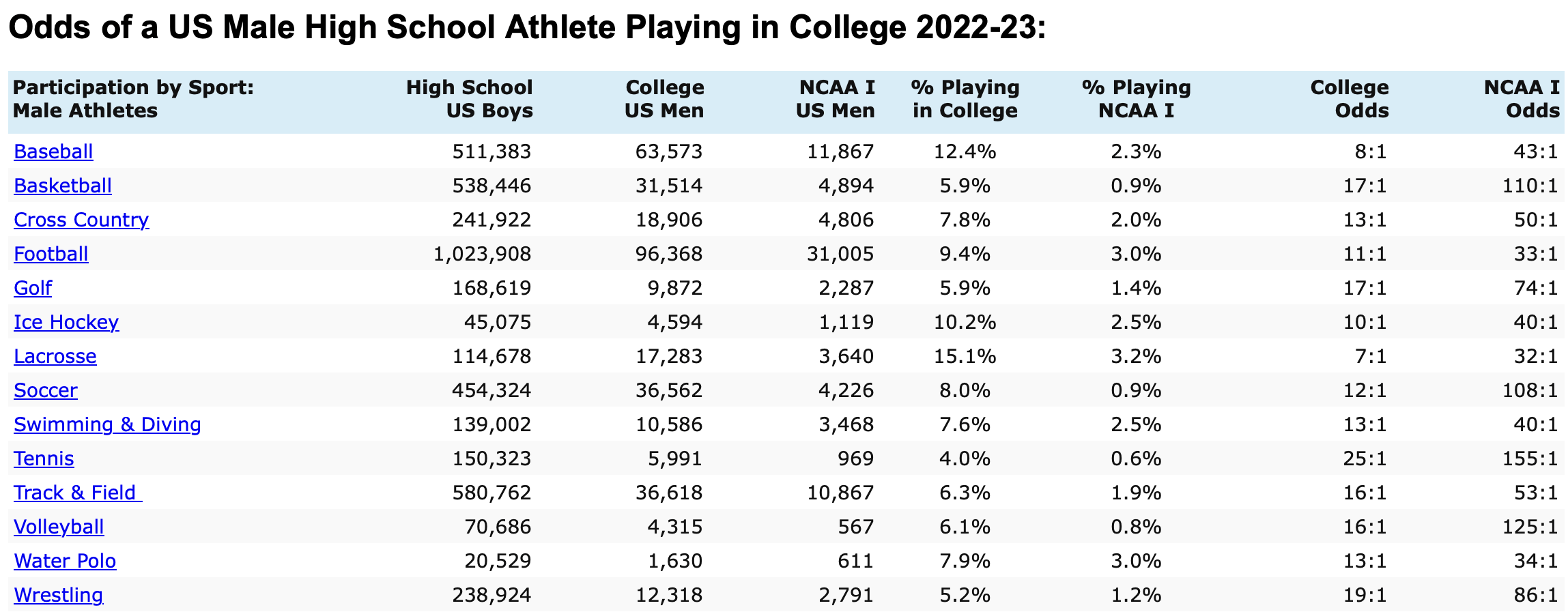
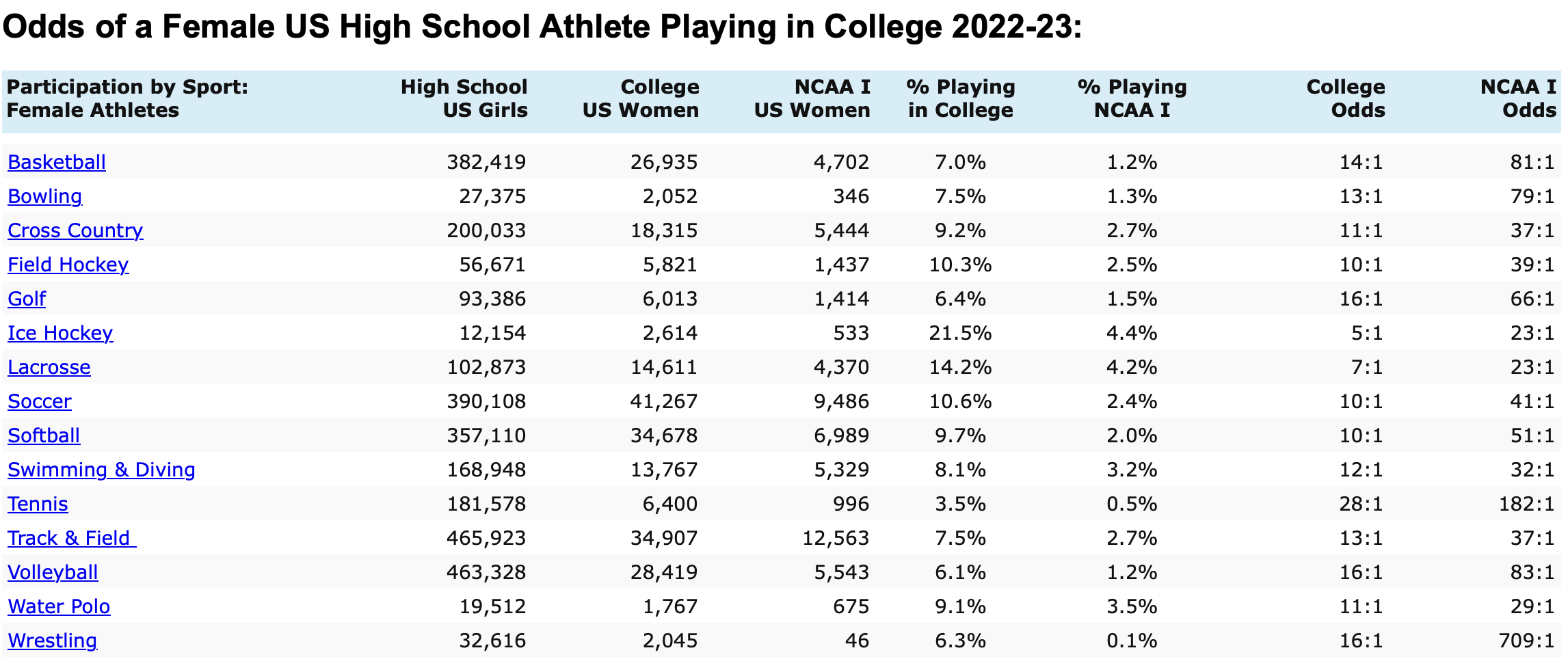
Your Competition Works Much Harder Or Is Much Wealthier Than You
Take a look at this video of young Chinese gymnasts practicing. Now compare that to how your kids are practicing. There’s little-to-no chance your child will ever surpass these kids because you won’t make them suffer as much.
These young athletes might not be rich, but they do have a system that pushes them to train incredibly hard. Yet, even with all that effort, most of them still won’t make it professionally.
In some cases, being poor might actually be an advantage in becoming a great athlete. When you’re poor, you might see excelling in sports as your main way out of poverty. Of course, if you’re rich, you’ll have endless funds for personalized training sessions.
For the USA women’s gymnastics to win gold feels even more amazing! Realize how much work ethic is required to get to the top 1% in everything.
Getting Better At Tennis Took A Lot Of Money And Effort
I’ll always remember one woman at my sports club joking, “I’ve paid $1 million for tennis lessons and still can’t properly hit a topspin backhand!”
When I started playing USTA league tennis in 2009, I self-rated as a 4.0-level player. After a couple of years of regular practice and matches, I got bumped up to 4.5.
Then in 2012, I engineered my layoff and suddenly had a lot of free time. I was making 80% less a year, but I used that time to play more tennis. Three years later, I got bumped up to 5.0, a level where fewer than 1% of league tennis players compete.
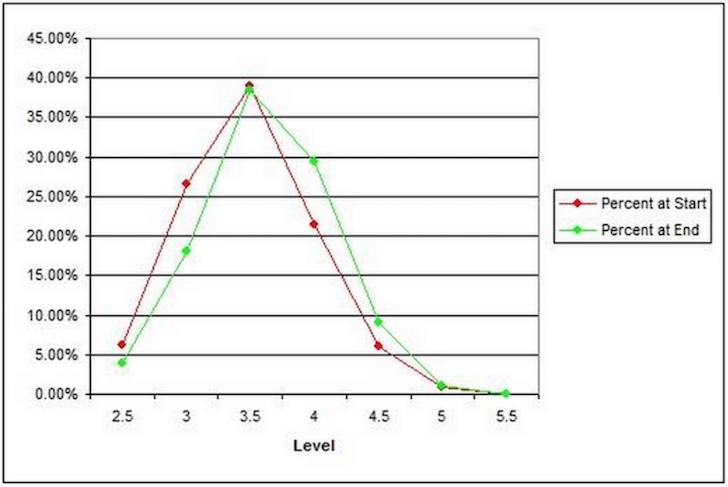
There was no way I could have reached the 5.0 level at age 38 without the time and money to practice so much. I’m just a regular guy with average power, skills, and speed. My opponents were ex-college players, mostly in their 20s and early 30s.
But I could practice for hours a day, while most of my peers at the 4.5 level were spending 8+ hours a day in the office. Therefore, it was tougher for them to get better.
The experience I gained from playing so many challenging matches boosted my mental toughness. I stayed at the 5.0 level for five years, until 2019. Then the pandemic hit, which enabled me to appeal down to 4.5 after two years of not playing.
The Cost of Becoming a Top 1% Tennis League Player
Given that I gave up a $250,000-a-year base salary job in finance in 2012, I could say it cost me $750,000 to become a 5.0 player. Of course, that’s not right since I didn’t quit my job just to play tennis. So maybe that cost was closer to $50,000. But still, that’s a lot of money.
Not only did I give up my salary to play more tennis, but I also spent more on healthier foods and better equipment.
I also paid, on average, $3,600 a year to be a member of my sports club, plus $200 annually in USTA fees. I could have saved money by solely playing at a public park, which I do as well, but I enjoyed the camaraderie of my fellow members.
If you don’t have similar time or resources to practice, moving up the ranks may be tougher. Less than 10% of 4.5 players ever get bumped up to 5.0. And I’d estimate that less than 3% of 4.5 players ever reach 5.0 after age 35.
But here’s the thing: as a 5.0 player, I was terrible! I lost about 80% of my matches. Despite all the money and time I spent training, I still wasn’t competitive enough at this high level.
If you dedicate enough time and money to your sport, you will eventually hit a ceiling. And that ceiling will no longer make the sport fun. I was frustrated and miserable for the last three years as a 5.0 player.
No Need to Be a Great Athlete to Have a Great Career
Since 1999, I’ve lived in a bubble where most of my friends are athletes. Many of my colleagues in banking played college sports. One was the backup QB for Cal who beat Stanford when John Elway was QB during “The Play.” Another colleague even won bronze in rowing at the Sydney Olympics.
But in 2022, after I started meeting parents at my son’s school, I realized that most adults are not athletes or no longer play sports as adults. This was baffling.
Yet, all of these parents earned enough to afford tuition at our independent school. While ~20% receive financial aid or help from their parents, it was clear that being a great athlete—or even being good at sports—is not necessary for career or financial success.
Instead, being a nerd seems to be a much stronger indicator for financial outperformance.
Easy For Parents To Spend A Lot Of Money On Youth Sports
One of the top criticisms of my various six-figure household budgets is that I allocate too much for kids. Ironically, many of these critics don’t have children. On the other hand, experienced parents often tell me I’m not budgeting enough for kids’ extracurricular activities. I believe them.
When you love your child more than anything, you’ll likely be inclined to spend on activities they find interesting. If you see potential for excellence in them, you might be willing to spend even more. After all, you don’t want to be “selfish” by limiting their potential.
Many parents will find themselves in an expensive situation where their kids love a sport but aren’t good enough to play in college, let alone professionally. Every dollar spent might not lead to tangible rewards, except for supporting the joys of their children. Be careful how much you spend.
Conversely, for those who’ve been fortunate enough to save and invest diligently for 20+ years, you may have excess funds. Then by all means decumulate wealth by spending it on your children’s sports. Even if they don’t end up with a college scholarship or a spot in the NBA, at least you’ll have given them every opportunity to enjoy an activity they love.
Be A Good-Enough Athlete Instead
You don’t need to be a great athlete, instead, focus on being a good-enough athlete. The idea is similar to being a good-enough investor to eventually get rich.
If you’re proficient in a couple of sports, you’ll maximize your enjoyment, meet new people, and have a fun way to stay active.
Ideally, aim to get good enough at tennis and golf—two sports that are excellent for business development and can be enjoyed for a lifetime. Pickleball might be next on the list, given its explosive growth in popularity. You’ll meet people young and old playing together.
We love sports in America, so it’s worth becoming good enough in at least one sport. Talking about sports with friends and colleagues builds camaraderie, but playing together takes that camaraderie to a whole new level.
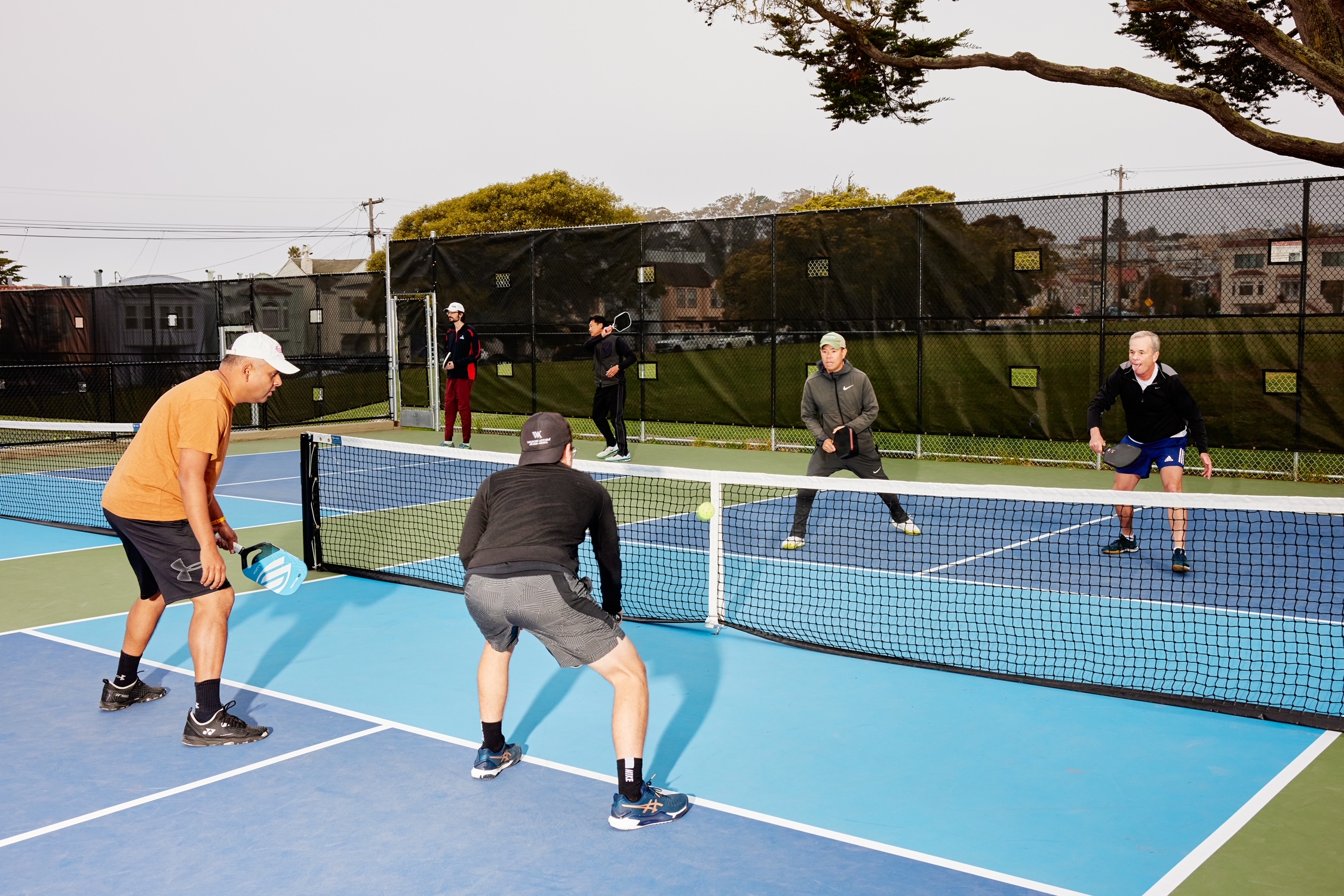
Do you think it costs a small fortune to excel in sports? If so, how do you calculate or measure the return on investment? Did playing sports help you get into a better university or land a better job? How do you decide how much to spend on your children’s sports activities? And when do you know it’s time to stop investing money in their sports?
A Discussion On Competing At The Highest Level Of Your Sport
Here’s a podcast episode I did with four-time NBA champion, Shaun Livingston, about what it takes to get to the NBA and win.
Recommendations
Pick up a copy of Buy This, Not That, my instant Wall Street Journal bestseller. The book helps you make more optimal decisions so you can live a better, more fulfilling life, which includes whether to spend a fortune on athletics.
To expedite your journey to financial freedom, join over 60,000 others and subscribe to the free Financial Samurai newsletter. You an also get my posts in your inbox as soon as they are published by signing up here. Financial Samurai is among the largest independently-owned personal finance websites, established in 2009.
Read the full article here





